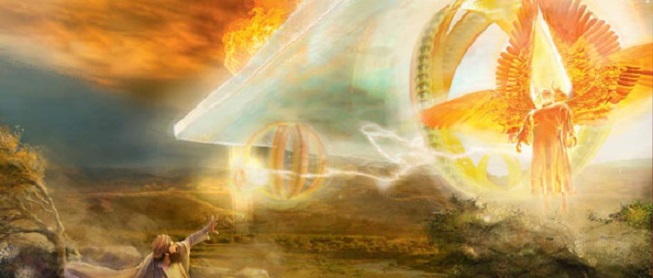This article is part of a series on Old Testament Christophanies. For important background information, see An Introduction to Old Testament Christophanies–with Justin Martyr.

The prophet’s vision continued in Ezekiel 9. The Lord called forth six executioners from Jerusalem, and among them was a man clothed in linen with a writing case at his side. The executioners and the man in linen went and stood beside the bronze altar, located in the temple complex (vv. 1–2). The seven men were there to await the Lord’s instructions. The man in linen may have been a priest since priests typically wore linen (e.g., Exod 28:39–42; Lev 16:4; 1 Sam 2:18). Or it could simply be that the man was clothed in a garment meant to signify the purity of his work. In verse 3, “the glory of the God of Israel” rose from its resting place between the cherubim and moved to the threshold of the temple. There is a good possibility that “the glory of the God of Israel” was still manifested as the glorified man (Ezek 8:2–4). The Lord ordered the man in linen to put a mark on the foreheads of everyone in Jerusalem who grieved over the abominations committed in the city. The executioners were then ordered to slay everyone in Jerusalem who didn’t have the mark (vv. 3–7). The man in linen came and reported to the Lord that he had completed his task (v. 11).
This directly led to Ezekiel 10. What Ezekiel was shown in this chapter—the expanse, the throne, the cherubim, and the wheels—in many ways repeats what he saw in chapter 1. In Ezekiel 10, the vision is centered around the glory of Yahweh departing the temple. This time Ezekiel saw the chariot-throne immediately:
Then I looked, and behold, in the expanse that was over the heads of the cherubim something like a sapphire stone, in appearance resembling a throne, appeared above them. And He spoke to the man clothed in linen and said, “Enter between the whirling wheels under the cherubim and fill your hands with coals of fire from between the cherubim and scatter them over the city.” And he entered in my sight (Ezek 10:1–2).
The natural inference is that Ezekiel saw the glorified man on the throne like he did in his first vision (Ezek 1:26–28). But whether Ezekiel could see Him or not, it was the Son of God who spoke from the throne—as He had before. The Son now ordered the man in linen to do a work of judgment, where before his work was one of mercy. The coals of fire symbolized the Lord’s wrath that would come upon Jerusalem (see 2 Kgs 25:9; 2 Chr 36:19).
When the man in linen entered the temple, the cloud of Yahweh’s presence filled the inner court. The cherubim stood nearby on the right side (or south side) of the temple (v. 3). These were the living cherubim, standing as servants, ready to receive Yahweh’s glory. In verse 4, the glory of Yahweh moved from the cherubim to the threshold of the temple, filling the court with the glory’s brightness. These cherubim are best understood as the two inanimate cherubim which sat atop the mercy seat (Exod 25:18). Thus, the description is of the glory preparing to leave the temple. In verses 6–7, the man in linen did as he was ordered; he went and stood beside a wheel near one of the living cherubim. The cherub took some of the fire that was there and gave it to the man, and he left with it.
The glory of Yahweh departed from the threshold and stood above the cherubim (v. 18). The glory of Yahweh was now seated on the chariot-throne. In verse 19, the glory moved to the temple’s east gate. The glory completely departed in Ezekiel 11:22–23 when “the glory of the God of Israel” left Jerusalem and stood over the Mount of Olives. The glory undoubtedly ascended to heaven soon after.
Moving slowly and pausing at times, the glory of Yahweh was so reluctant to leave the temple. The glory’s departure ended Israel as a kingdom of priests—the kingdom that started when Yahweh in His glory descended on Mount Sinai (Exod 19). But there was good news; the glory wouldn’t stay gone forever. It would return as Jesus Christ, who is the very personification of Yahweh’s glory (Matt 17:1–5; John 1:14; 2 Pet 1:16–18). Matching the departure of Yahweh’s glory, Jesus ascended in a cloud of glory from the Mount of Olives (Acts 1:9, 12) after He was rejected as Messiah and King.

I feel sure that all theophanies are manifestations of the Holy Spirit. Otherwise to believe they are Jesus leads to a slippery slope where The incarnate Jesus gets demoted to a spiritual manifestation too. A heresy.
The Son is clearly stated to be the member the Godhead who represents God to mankind (e.g., John 1:18). Can you provide a passage that teaches that the Holy Spirit takes on human form to represent God, instead of coming upon or dwelling on a person?
The fact is that some Theophanies are undoubtedly the Son. Just for one example, compare Isaiah 6 with John 12:40-41. I am certainly not suggesting that the incarnate Son of God is a “manifestation” as you say. Indeed, my entire series argues that Christophanies are for the purpose of foreshadowing the Incarnation. I resent the suggestion that I am teaching a heresy. I would hope for more respectful interaction. Say, ask me before lobbing an accusation?